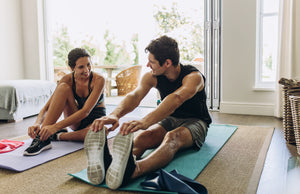Benefits of At-Home Cardio Exercises
Jun 02, 2020
There’s no need to shell out cash on workout classes or a gym membership if you have an open patch of floor space in your living room or basement. Regular cardio exercise comes with a host of benefits, so maximize your at-home time by fitting in a workout whenever you can.
Benefits
On some days, you may not have time to leave the house for a workout. But in the minutes it would take you to commute to and from the gym, you can get an entire exercise session in at home. According to the American Heart Association, as little as 10 to 15 minutes of exercise at a time can boost your cardiovascular health.
Other benefits of cardio workouts include weight management, disease prevention, mood and energy elevation and improved sleep quality. Weber State University professor Dr. Michael Olpin also writes that regular exercise can improve your appearance, control your appetite and help you maintain an independent lifestyle as you age.Recommendations
The AHA suggests that healthy adults get at least 150 minutes of moderate-intensity or 75 minutes of vigorous-intensity cardio exercise per week.
If you have a treadmill or an elliptical machine at home, fulfilling those guidelines is easy — just hop on for a half hour at a time on most days of the week. No machines? No worries. Work up a sweat by jogging in place, performing butt kicks or high knees, jumping rope, doing jumping jacks, burpees or mountain climbers or even performing sets of rapid squats and lunges.Set Routines
You don’t have to put a lot of time into planning a home cardio workout to make it effective – as long as you break a sweat and raise your heart rate, you’re doing well. However, planned routines can make the time fly by faster and can give you a more balanced workout. Try doing 60-second sets of jumping jacks, jumping rope, butt kicks, high knees and jogging in place, with a 30-second rest in between each set. Repeat the circuit four times and you have an effective, high-intensity, 20-minute cardio workout that you can do anywhere. If those exercises get repetitive, switch them out with alternatives like squat jumps, mountain climbers, pushups, skaters or bicycle crunches.
Keeping It Safe
There’s no personal trainer to keep an eye on you when you’re working out at home, so it’s important to be as safe as possible, especially if you’re new to exercise, have a medical condition or are dealing with an injury. The National Health Service recommends starting any cardio workout with a five-minute warmup and ending with a five-minute stretch session. During your warmup, gradually raise your heart rate by marching in place, swinging your arms and legs, jogging in place and rolling your shoulders.
After your workout, stretching the muscles you’ve challenged can improve your circulation, range of motion and flexibility.References & Resources
- American Heart Association: American Heart Association Recommendations for Physical Activity in Adults
- MayoClinic.com: Exercise – 7 Benefits of Regular Physical Activity
- Weber State University: Benefits of Aerobic Conditioning
- National Health Service: 10-Minute Home Cardio Workout
- National Health Service: How to Warm Up Before Exercising
- Gaiam: How Does Stretching Benefit My Cardio Workout?





